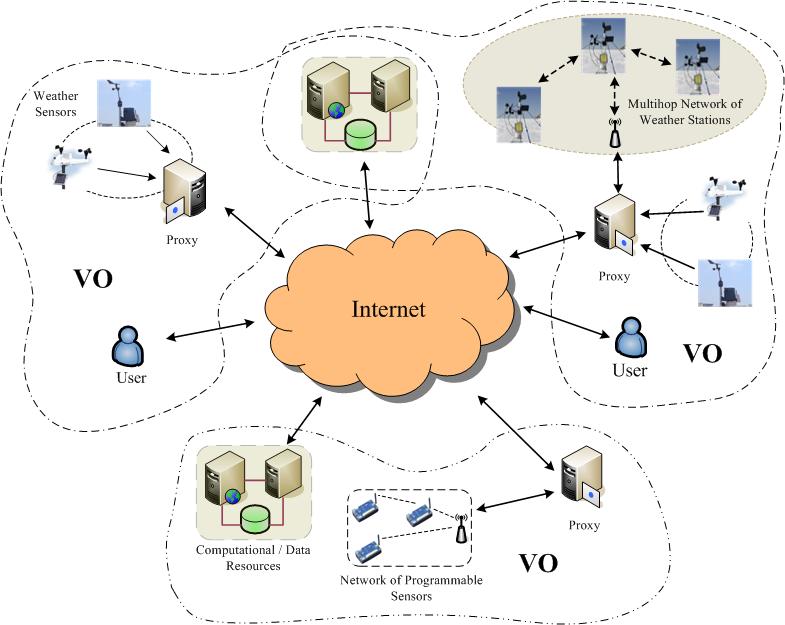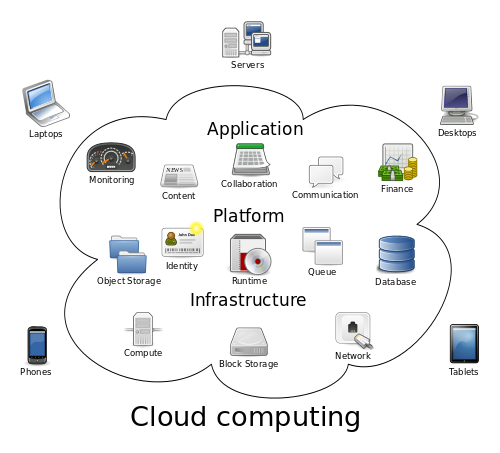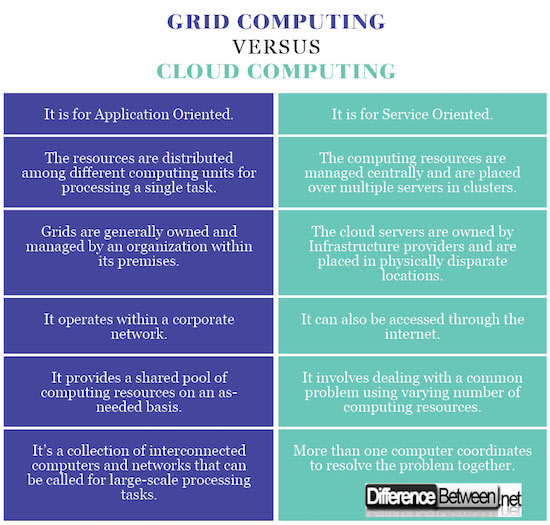Difference between Grid Computing and Cloud Computing
Grid computing and cloud computing are conceptually similar that can be easily confused. The concepts are quite similar and both share the same vision of providing services to the users through sharing resources among a large pool of users.
Both are based on network technology and are capable of multitasking meaning users can access a single or multiple application instances to perform different tasks.
While grid computing involves virtualizing computing resources to store massive amounts of data, whereas cloud computing is where an application doesn’t access resources directly, rather it accesses them through a service over the internet.
In grid computing, resources are distributed over grids, whereas in cloud computing, resources are managed centrally. Let’s take a brief look at the two computing technologies.
What is Grid Computing?
Grid computing is a network based computational model that has the ability to process large volumes of data with the help of a group of networked computers that coordinate to solve a problem together.
Basically, it’s a vast network of interconnected computers working towards a common problem by dividing it into several small units called grids. It’s based on a distributed architecture which means tasks are managed and scheduled in a distributed way with no time dependency.
The group of computers acts as a virtual supercomputer to provide scalable and seamless access to wide-area computing resources which are geographically distributed and present them as a single, unified resource to perform large-scale applications such as analyzing huge sets of data.

What is Cloud Computing?
Cloud computing is a type of internet-based computing where an application doesn’t access the resources directly, rather it makes a huge resource pool through shared resources. It is modern computing paradigm based on network technology that is specially designed for remotely provisioning scalable and measured IT resources.
It allows on-demand access to a shared pool of dynamically configured computing resources and higher-level services thereby eliminating the need of massive investments in local infrastructure. The computing resources are managed centrally which are located over multiple servers in clusters. Users can access software and applications from wherever they need without worrying about storing their own data. It simply breaks down to “pay only for what you need”.

Difference between Grid Computing and Cloud Computing
-
Technology involved in Grid Computing and Cloud Computing
– Grid computing is form of computing which follows a distributed architecture which means a single task is broken down into several smaller tasks through a distributed system involving multiple computer networks. Cloud computing, on the other hand, is a whole new class of computing based on network technology where every user of the cloud has its own private resource that is provided by the specific service provider.
-
Terminology of Grid Computing and Cloud Computing
– Both are network based computing technologies that share similar characteristics such as resource pooling, however, they are very different from each other in terms of architecture, business model, interoperability, etc. Grid computing is a collection of computer resources from multiple locations to process a single task. The grid acts as a distributed system for collaborative sharing of resources. Cloud computing, on the other hand, is a form of computing based on virtualized resources which are located over multiple locations in clusters.
-
Computing Resources in Grid Computing and Cloud Computing
– Grid computing is based on a distributed system which means computing resources are distributed among different computing units which are located across different sites, countries, and continents. In cloud computing, computing resources are managed centrally which are located over multiple servers in clusters in cloud providers’ private data centers.
-
Research Community
– In grid computing, computing resources are provided as a utility with grids as a computing platform that are distributed geographically and are grouped in virtual organization with multiple user communities to solve large-scale problems over the internet. Grid involves more resources than just computers and networks. Cloud computing, on the other hand, involves a common group of system administrators that manage the entire domain.
-
Function of of Grid Computing and Cloud Computing
– The main function of grid computing is job scheduling using all kinds of computing resources where a task is divided into several independent sub-tasks and each machine on a grid is assigned with a task. After all the sub-tasks are completed they are sent back to the main machine which handles and processes all the tasks. Cloud computing involves resource pooling through grouping resources on an as-needed basis from clusters of servers.
-
Application of Grid Computing and Cloud Computing
– The term “cloud” refers to the internet in cloud computing and as a whole it means internet-based computing. The cloud manages data, security requirements, job queues, etc. by eliminating the needs and complexity of buying hardware and software needed to build applications which are to be delivered as a service over the cloud. Grid computing is mostly used by academic research and is able to handle large sets of limited duration jobs that involve huge volumes of data.
Grid Computing vs. Cloud Computing: Comparison Chart

Summary of Grid Computing Vs. Cloud Computing
Both grid computing and cloud computing are network-based computing technologies that involve resource pooling, but cloud computing eliminates the complexity of buying hardware and software for building applications by allocating resources that are placed over multiple servers in clusters.
Grid computing, on the contrary, is a computing technology that combines computing resources from various domains to reach a common goal.
The computers on the network work on a task together and every computer can access the resources of every other computer within the network.
In simple terms, grid computing is a group of interconnected computers that work together to handle huge volumes of data.
- Difference Between Caucus and Primary - June 18, 2024
- Difference Between PPO and POS - May 30, 2024
- Difference Between RFID and NFC - May 28, 2024
Search DifferenceBetween.net :
3 Comments
Leave a Response
References :
[0]Buyya, Rajkumar, James Broberg, and Andrzej M. Goscinski. Cloud Computing: Principles and Paradigms. New Jersey: John Wiley & Sons, 2010. Print
[1]Jamsa. Cloud Computing. Burlington: Jones & Bartlett Learning, 2012. Print
[2]Grandinetti, Lucio. Grid Computing: The New Frontier of High Performance Computing. Amsterdam: Elsevier, 2005. Print
[3]Image credit: https://upload.wikimedia.org/wikipedia/commons/thumb/b/b5/Cloud_computing.svg/500px-Cloud_computing.svg.png
[4]Image credit: https://en.wikipedia.org/wiki/File:Sensor_Grid_architecture-new.jpg#/media/File:Sensor_Grid_architecture-new.jpg

I am happy to subscribe to your website. This sends me an email notification. I become updated with your knowledge. Thanks for sharing such a novel job. I love cloud computing. Would you please post some IoT related post. Thanks once again.
Regards
Good material. Thanks for sharing
Thanks for this it was really helpful
If you are a girl please do check out my articles and help me to grow up on this platform